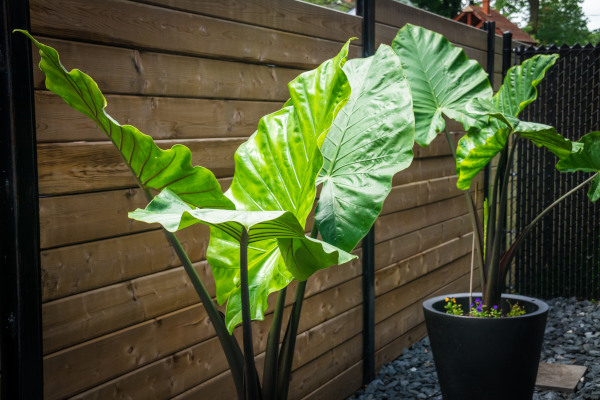How to grow Colocasia
Also known as elephant’s ears, colocasia is a tender, tuberous perennial from swampy and moist areas in tropical Asia. It is grown for its huge and impressive heart-shaped leaves in shades of purple, lime green, or black, often with a velvety texture. While there are several species, by far the most widely cultivated is Colocasia esculenta. Though primarily grown as an ornamental plant in the UK, in the tropics it is a staple food known as taro, similar to sweet potatoes or yams.
Unable to withstand a UK winter outdoors, colocasia tends to be either grown as a houseplant or treated in the same way as dahlias i.e., the tubers lifted and dry stored over winter. Although evergreen, it is likely to lose its leaves if temperatures dip below 21°C.
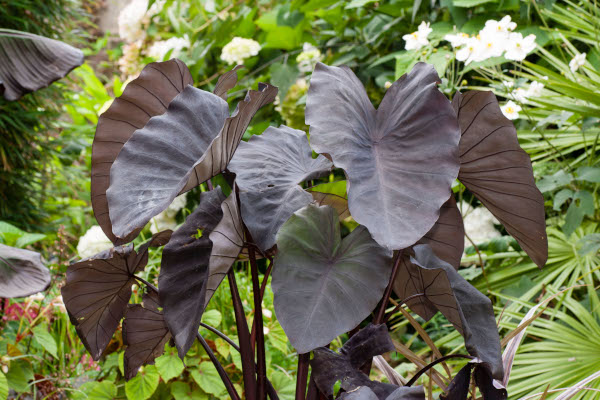
Key Information
Position
Soil Conditions
Hardiness

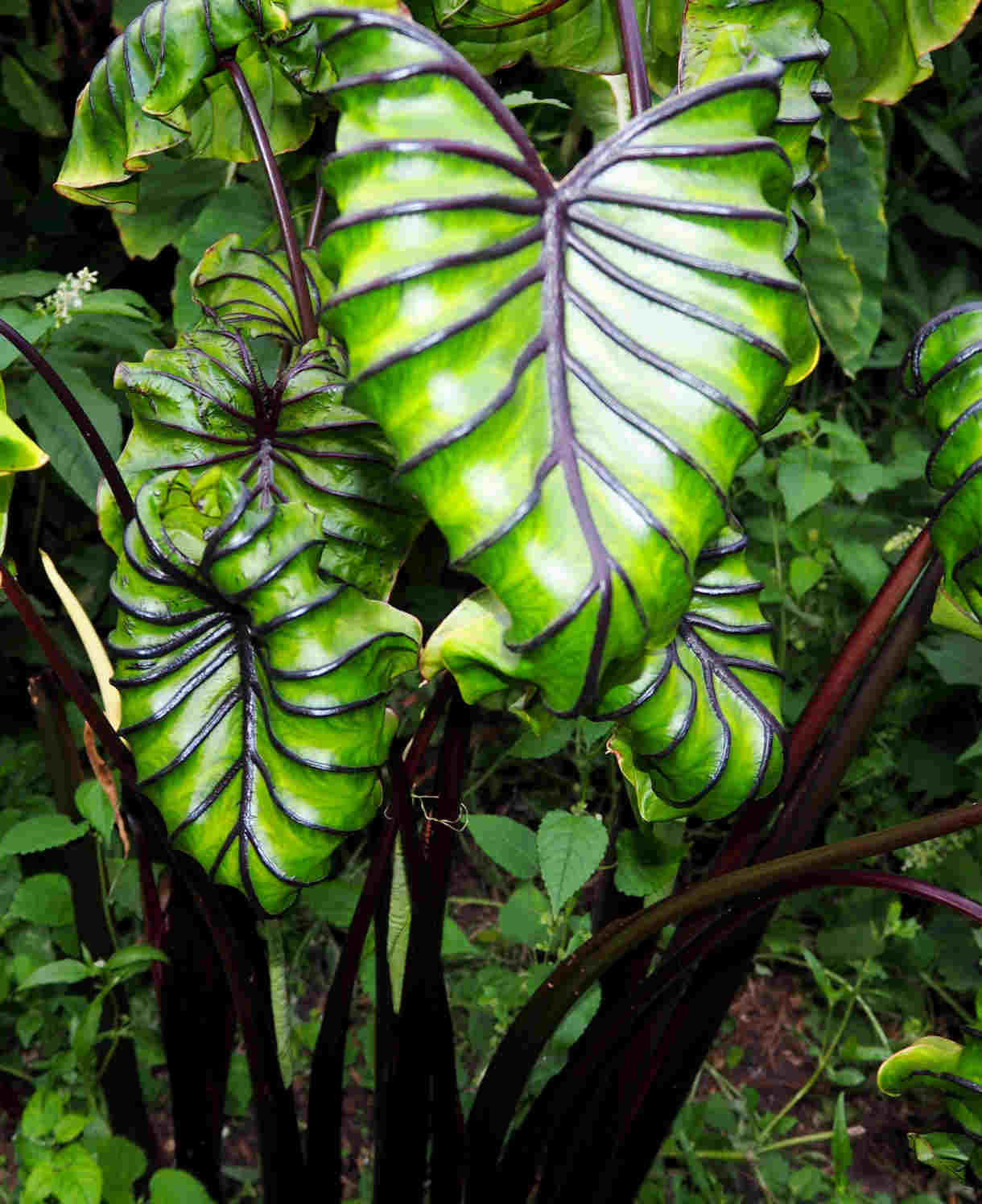
Where & when to plant Colocasia
Position - Outdoors: grow in full sun, Indoors: bright yet indirect light.
Soil - Outdoors: fertile, humus-rich, moist or wet soil with a slightly acidic pH, Indoors: loamless potting compost.
Flowering Period - Summer, though grown mainly for foliage.
Hardiness - Subtropical, with a rating of H1B. This means the lowest temperature it can withstand is in the 10°C to 15°C range.
While you can buy colocasia as bare, dormant tubers, we tend to send ours out as pot-grown plants during the growing season. These can be planted out or potted up anytime between late spring and autumn.
If you’re growing yours outside, ideal spots include moist, exotic borders, or around the edges of a pond.
Indoors, humidity, warmth, and light are key. Light should be bright yet not harsh and glass-amplified, so set back slightly from a south facing window, on an east or west facing windowsill, or in a sunny spot with some form of light shading (net curtain, adjustable blind etc.). When it comes to humidity, the best spots are usually steamy bathrooms or kitchens. Failing that, either place the pot on a tray filled with pebbles and regularly topped-up water, or get busy with the misting bottle.
A final note is to make sure you have enough space to grow colocasia; it can reach up to 1.5m in both directions!
How to plant Colocasia
- For planting in the garden, dig the soil area removing any large stones and weeds and breaking up any lumps. It can be a good idea to mix in some organic matter such as manure or garden compost at this stage, particularly if you have poor or heavy soil.
- Rake level and firm with your heels. Rake level again.
- Water plants well and allow to drain before planting.
- Dig a hole twice the size of the root-ball.
- Place the plant in the hole, ensuring the top of the root ball sits level with the surface of the soil. Too low and the plant may rot, too high and the roots can dry out.
- Backfill with soil and firm in gently with your foot.
- Soak well with water.
- Mulch around the base with well-rotted organic matter.
- For planting in containers, aim for a large pot measuring around 25cm across, ensuring there are plenty of drainage holes in the bottom.
- Use a good quality potting compost containing slow-release fertiliser granules.
- Start by partially filling the pot with compost; enough so that when placed on it the upper surface of the root ball is about 3cm lower than the top of the pot.
- Fill around the plant with compost, firming down with your fingers then adding a little more so it is held tight.
- Pick up the container (if you can!) and lightly tap on the potting bench or ground a few times to help further settle the compost around the plant.
- Soak well with water.
- A mulch with horticultural grit will look attractive and help to prevent a ‘cap’ or crust forming on the top of the compost (something container plants can suffer due to the artificial nature of their watering).
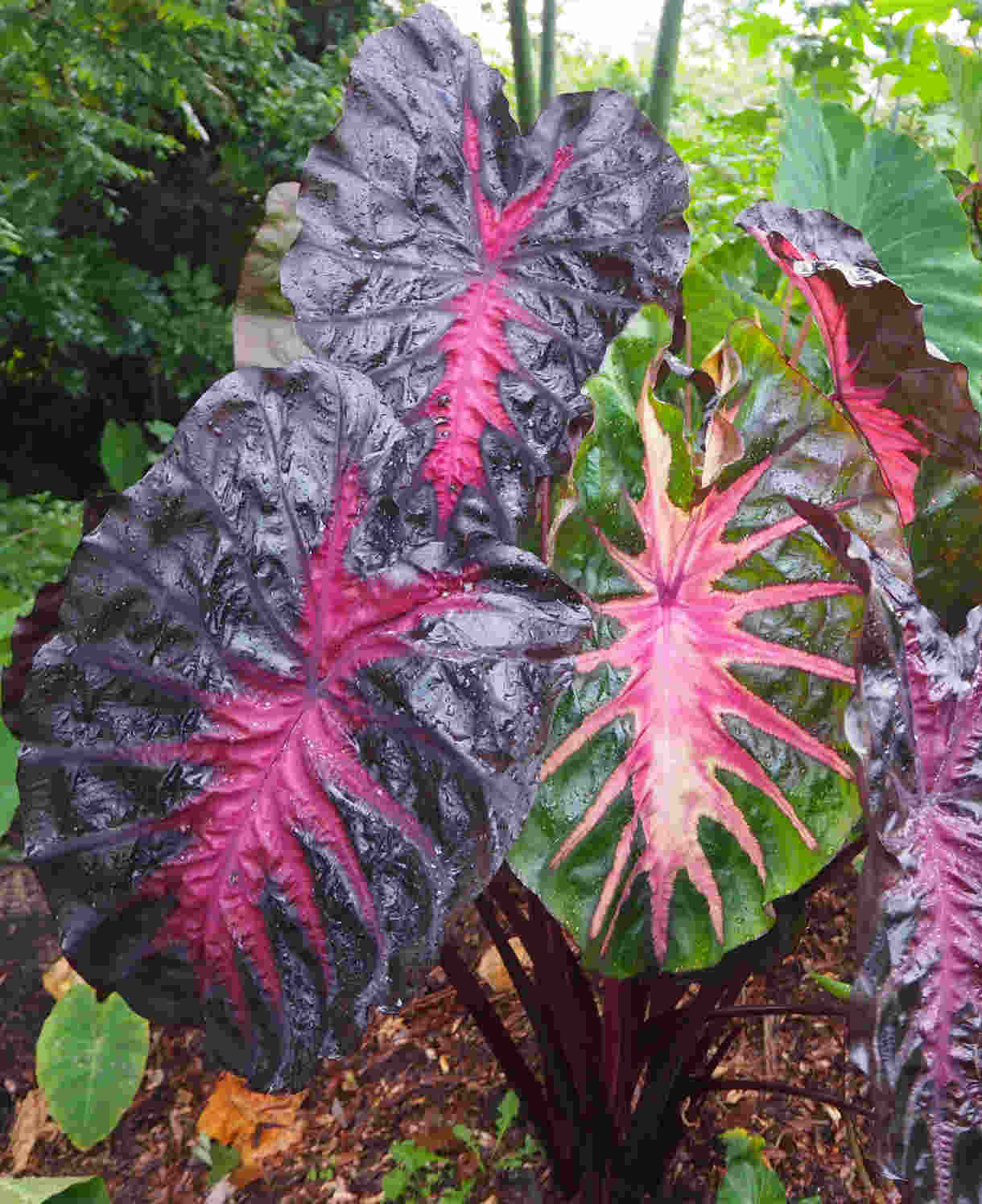
What to plant with Colocasia
Outside, combine colocasia with other exotic foliage plants for a lush, jungle-like display – think musa, ensete, fatsia, and phormium. Add bright, jewel-like flowers like kniphofia, dahlia, canna, and agapanthus for striking pops of colour.
If you would like any further planting ideas or growing advice for your colocasia, please contact our friendly and knowledgeable Customer Care Team - we will be more than happy to help you.

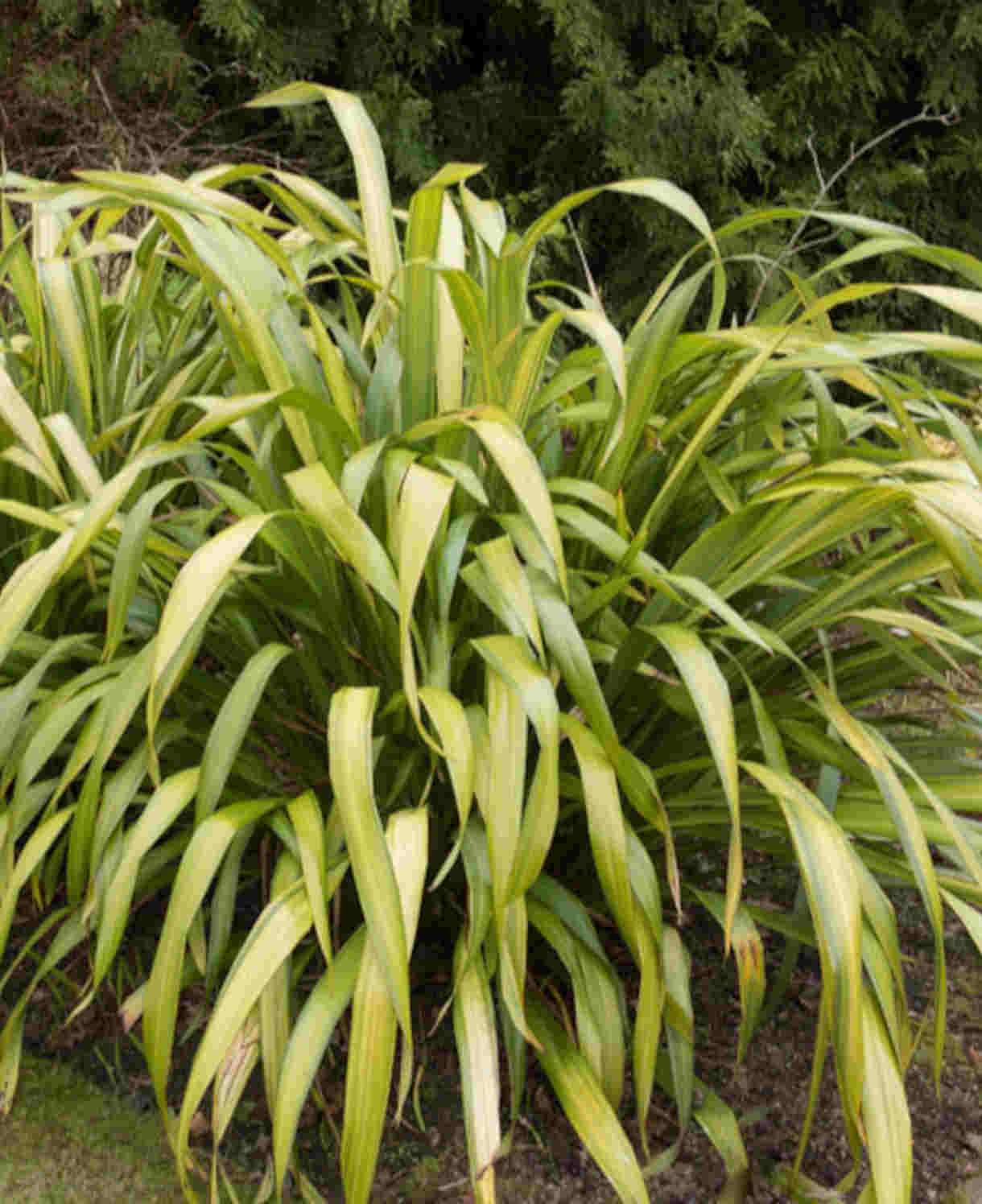
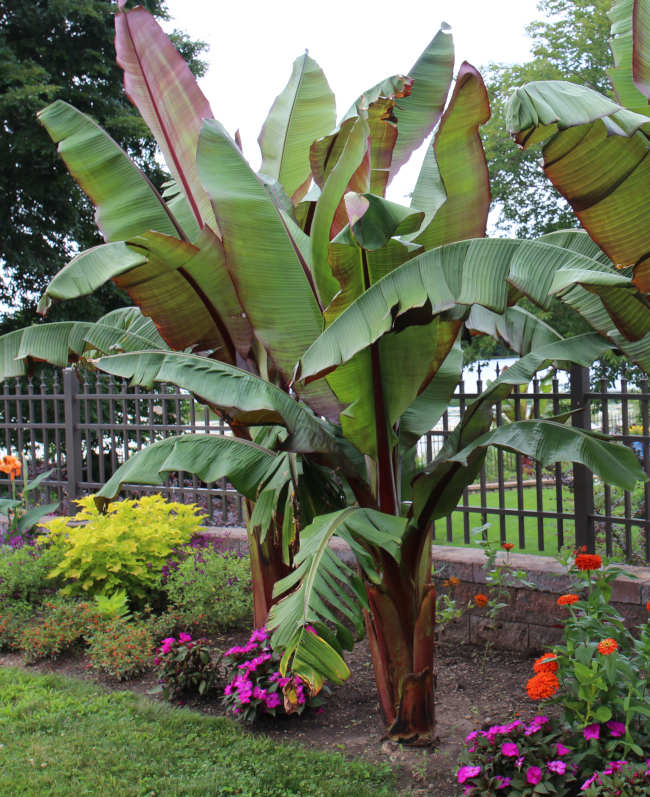
How to care for Colocasia
Pruning and Deadheading
Colocasia is likely to die back as temperatures dip below 21°C. Simply cut away withered foliage and wait for it to regrow the following spring.
Watering
Colocasia in the open ground needs watering generously throughout the growing season. As a rule of thumb, aim for a good soaking every couple of weeks, increasing the frequency in hot, dry weather. Those gardening on sandy soil will need to water more often than this.
Container-grown colocasia needs even more attention as its roots have less access to rainfall. Water freely throughout the growing season, aiming for consistently moist but not soggy compost. Scale this back during winter, keeping compost just moist enough to prevent drying out completely.
Feeding
Wherever you grow it, colocasia will thank you for a monthly dose of a balanced liquid feed throughout the growing season (a seaweed feed is ideal).
Outdoors, a generous layer of nutrient-rich mulch (e.g. well-rotted manure or garden compost) should be applied when planting. As well as boosting soil fertility, this has the added benefit of suppressing weeds and locking in moisture.
Cold Protection
Colocasia hails from far warmer climes than ours and can only live outside in the UK during the mildest months. There are a few ways you can approach this. Either:
- Keep indoors as a permanent houseplant
- Grow as a houseplant but move outdoors in summer
- Plant in the ground and treat as you would a dahlia. This means lifting the tubers in autumn, cutting away any remaining foliage, and storing somewhere dry and cool yet frost free over winter. Pot up in early spring (pointy end or the end with the most concentric rings facing up and sitting a couple of centimetres below the surface) and place in a warm greenhouse or on a sunny windowsill to bring back into growth – this happens at around 18°C. Plant outside once all risk of frost has passed.
Pests and Diseases
Outdoors, you may find the soft, new growth of colocasia is susceptible to slug and snail damage. Encouraging natural predators into your garden, such as birds, frogs, toads, and hedgehogs makes a big difference. Torchlight searches after dark (when slugs and snails are at their most active) are also effective, allowing you to collect the offending molluscs in a bucket and dispose of as you see fit. Relocating to a nearby woods or bagging up and putting in your freezer before popping them in the bin are said to be the most humane approaches.
Indoors, the usual issues of spider mite and aphid can crop up. Again, keeping houseplants as healthy as possible is the key to warding off problems, and by this we mean proper ventilation, adequately spaced plants (for good air flow), keeping everything well-watered and fed, and repotting into larger containers when necessary. Thoroughly cleaning the indoor environment every winter can also help to remove overwintering populations of pests.
Where infestations do take hold, try introducing biological controls (often sachets or tubes containing miniscule natural predators), or in the worst cases, remove the affected plant/s altogether.
How to propagate Colocasia
Colocasia can be propagating by division during winter. Established corms will produce small offsets (baby corms), and it is simply a case of teasing these away from the parent and potting up into individual containers. Place in a heated propagation unit if you have one to provide a head start into growth before spring arrives. Give just enough moisture to prevent drying out completely – too much at this stage is likely to encourage fungal problems.
* Many plants carry Plant Breeders Rights and cannot be propagated for commercial purposes.
Common Colocasia questions
Can you grow colocasia indoors?
Indeed you can, both permanently and as an overwintering solution.
How long does colocasia take to grow?
It can take 2-3 years for offsets to reach maturity. Mature tubers produce full sized top growth within one growing season.
Can I plant my stored tuber straight into the ground in spring?
Tubers may rot if the soil is too cold and wet in spring, therefore it is best to start them off indoors in pots.
My colocasia leaves are turning yellow, what’s the problem?
If this is happening in autumn, it’s likely to be the natural process of the leaves dying back for winter. If at other times during the growing season, there may be a problem with feeding and watering. Check our guidelines above to make sure you’re getting the care of your colocasia right.
I’ve read that colocasia is poisonous, but it’s also an edible crop. I’m confused!
All parts of colocasia can be poisonous if ingested raw, and can also irritate the skin. Wear gloves when handling, and if you do decide to try and eat the tubers make sure you cook them first. They are best eaten within a couple of weeks of harvesting in autumn (lifting them as the leaves die back), and can be prepared in the same way as potatoes.
